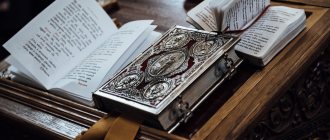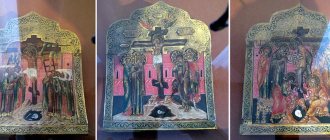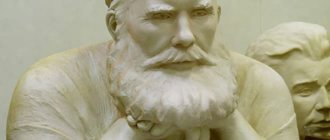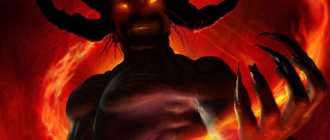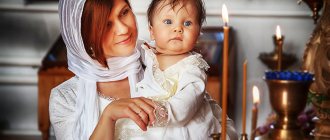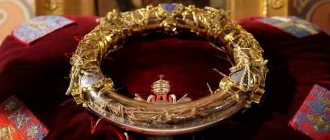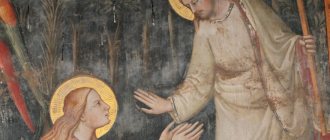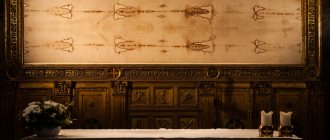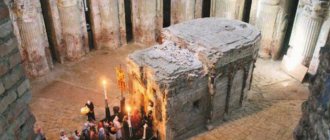The last years of the life of the Blessed Virgin Mary
Throughout her earthly life, the Most Pure One experienced many sorrows: the birth of her Son in a cattle cave, flight to Egypt, poverty, slander, separation from her Son, and, most terrible of all, His death on the cross. And although She Herself did not experience bodily torment, the weapon passed through Her soul as predicted by Simeon, when She saw Her Son suffering. Until His death on the cross, the Most Holy Theotokos followed Him and stood next to Him.
She endured everything silently, without murmur . She was not allowed to tell anyone who She was actually carrying in her womb. She endured when the time came for Her to be separated from the Divine Son. On Golgotha, She silently watched the painful death of Her beloved Son, and only God the Father knew that Her heart was breaking into pieces. And only when His body was taken down from the cross, She could not stand it and began to sob.
Having resurrected, Christ, according to legend, first appeared to His Mother and consoled Her. After His ascension, the Most Pure One missed Her Son. Every day she went to the Garden of Gethsemane and prayed there, asking the Son to quickly take Her to Himself. One day the Archangel Gabriel appeared to Her and gave her a branch from the Garden of Eden . She kept this branch until her death. The Archangel again brought Her good news: Her prayers were heard, and soon She would depart from earth to heaven.
Virgin MaryHoly Mother of God
Earthly mother of Jesus Christ. One of the most revered personalities and the greatest of Christian saints. Archangel Gabriel appeared to her and announced that, according to divine choice, she would become the mother of Jesus, the Son of God. According to the canonical Gospel, she was also present at the crucifixion of Christ. At the end of her earthly life, her body went to heaven.
Mary was born in the 1st century BC. in the city of Nazareth, Israel. Father, Joachim, is a believing and righteous man. A mother named Anna, like her husband, always followed the letter of God's Law. This family lived in complete harmony, only one thing darkened the existence of the spouses: the absence of children. For many years they prayed that God would send them a child, but their prayers were in vain.
We had been married for almost fifty years and were already desperate to have a child. But one day Anna, walking through the garden, saw an angel. He promised the surprised woman that he would soon become a mother, and her child would be known to the whole world. She hurried home to tell her husband about the vision. Imagine her surprise when it turned out that Joachim had also seen an angel who announced that the prayers for the child had been answered.
The couple raised their daughter and were preparing to fulfill their promise. Three years later, little Maria was sent to be raised in the Jerusalem temple. Surprisingly, the girl easily climbed the fifteen steps to the temple gates, which were sometimes difficult for adults too.
A few years later, the righteous Anna and Joachim died. Maria continued to live at the temple, studying together with other girls in a special school. Here, young pupils were taught the basics of science, taught the Word of God, and also prepared for worldly life, housekeeping and raising children. The girl was best at sewing. There is a legend that it was she who was entrusted with sewing the curtain and bedspread for the temple sanctuary.
Given such an upbringing, Mary should have grown into an enviable bride - hardworking, pious and educated. But such a fate did not attract the girl, and she took a vow of celibacy. This created certain difficulties: mature girls were not allowed to live at the temple, and the grown-up Mary had to leave God’s house.
But according to the laws of that time, she was not allowed to live alone. The clergy, who became attached to their pupil, found a way out: twelve-year-old Mary was given to the elderly widower Joseph, who, due to his age, must preserve the girl’s purity, allowing her not to break her word given to God.
At first, the old man was not happy about the young bride who fell on his head. In addition, the man was afraid of gossip behind his back and ridicule of relatives and neighbors - the age difference was so great. However, he did not dare to contradict the will of the priests and took the girl into the house, calling him his wife.
After some time, Joseph, who worked as a carpenter, left home for several months, going to another construction site. Maria, remaining on the farm, looked after order, weaved and prayed a lot. According to legend, while she was praying, an angel appeared to the girl and told her about the imminent birth of her son.
The boy, according to the angel, was destined to become the savior of people, the one whose coming the Jews had long awaited. Mary was embarrassed by this revelation, because she remained a virgin. To which she received the answer that she would suffer from a higher power, and not from the male seed. This day in the Christian tradition has become the Feast of the Annunciation - in memory of the good news that the Virgin Mary received.
And indeed, Maria soon realized that she was pregnant. The woman did not yet realize the role that her son had to play, but she understood that she had become a participant in a real miracle of the immaculate conception.
Joseph, who returned home after some time, immediately noticed the changes that had occurred in his wife. This kind man did not immediately believe Maria’s story, deciding that the naive girl had simply become a victim of deception by some neighbor’s young man who had seduced her.
The old man did not blame his wife and even wanted to secretly allow her to leave the city so that she would not become a victim of justice: treason in those days was severely punished, an unfaithful woman could be stoned and whipped. Then an angel appeared to the carpenter, telling him about the immaculate conception of Mary. This convinced Joseph of his wife’s innocence, and he allowed the girl to stay.
Shortly before the due date, Caesar Augustus announced a general population census. To do this, people had to come to Bethlehem on their own. Joseph and Mary set off on their journey. Arriving at the place, we found that the city was simply overcrowded with crowds of people. It was not possible to find a place to stay for the night, and the couple decided to spend the night in a cave in which the shepherds hid their cattle from the rains.
It was there that Mary gave birth to a son. The boy's first cradle was a manger for feeding animals. That same night, the star of Bethlehem shone above the cave, the light of which told people about the appearance of a miracle on earth. In addition, the light of the star was seen by the Magi, who immediately set off on their journey to personally worship the newborn Son of God and present him with gifts.
Seven days later, as required by the law of the time, the baby was circumcised and given a name. The son of the Virgin Mary was named Jesus. Then the boy was brought to the church to present him to God and make the traditional sacrifice. A certain elder Simeon, who also came to the temple that day, blessed the baby, realizing who was in front of him. The girl allegorically hinted that both she and her son were destined for a difficult fate.
While the Holy Virgin Mary was in Bethlehem with her husband and newborn baby, the cruel and ambitious King Herod learned about the birth of the Son of God. However, the predictors who told about the miracle that happened could not answer the question into whose family Jesus was born.
Then, without hesitation, the king ordered the destruction of all the newborns that were in Bethlehem. Joseph was warned about the impending trouble by an angel who again appeared to the elder in a dream. Then the carpenter took refuge in Egypt with Mary and the baby, and only when the danger had passed did he return with his family to his native Nazareth.
Mary accompanied Jesus Christ everywhere, supporting him and helping him bring the Word of God to people. The woman was also present at the miracle performed by Jesus, who turned water into wine. The Mother of God had a hard time: the constant sermons that her son preached did not always evoke a good response in people. Often I had to endure ridicule and aggression from those who did not want to accept the tenets of religion.
On the day when Jesus Christ was crucified by the executioners of Pontius Pilate, Mary felt the pain of her son and even fainted when the nails pierced his palms. And although the Mother of God knew from the very beginning that he was destined to accept torment for the sins of people, his mother’s heart could hardly withstand such suffering.
According to legend, the Mother of God was present at the Ascension of the Lord. After this, she remained in Jerusalem along with other disciples of Christ, awaiting the promised descent of the Holy Spirit. Mary participated in the distribution of lands by lot among the apostles, to which they were to go to preach. Georgia fell to her, but, at the command of Jesus Christ, Apostle Andrew went there.
Mary spent the rest of her life on Athos, preaching among the pagans and carrying the Word of God. The Mother of God spent all her days in prayer, asking her son to take her to him. One day, an angel appeared to the woman again, announcing that her prayers had been heard, and after three days her wish would be fulfilled.
On the appointed day in 48 , Mary, lying on her deathbed, humbly awaited her fate. People close to her gathered around her. They all witnessed a new miracle: Jesus Christ himself descended from heaven to take his mother with him. The soul of the Mother of God left the body and ascended into the Kingdom of God. The body that remained on the bed seemed to glow with grace.
Some time later, the apostles discovered that the body of the Virgin Mary had disappeared from the burial cave. On the same day, the Mother of God appeared to them and announced that her body had been ascended to heaven following her soul, so that she could become a Holy Intercessor before God for people in need of help.
Memory of the Virgin Mary
Memory of the Virgin Mary
In the Orthodox Church, the Nativity of the Blessed Virgin Mary - September 21 Entry into the Temple of the Blessed Virgin Mary - December 4 Annunciation of the Blessed Virgin Mary - April 7 Dormition of the Blessed Virgin Mary - August 28 Memory of the Righteous Saints Joachim and Anna, parents of the Mother of God - September 22 Conception of the Righteous Anna of the Blessed Virgin Mary - December 22 Council The Most Holy Theotokos - January 8 The Protection of the Most Holy Theotokos - October 14 The position of the honorable robe of the Most Holy Theotokos in Blachernae - July 15 The position of the belt of the Most Holy Theotokos in Chalcopratia - September 13 The Praise of the Most Holy Theotokos (Saturday Akathist), in memory of the miraculous defense of Constantinople from the Avars and Persians in 621 year, 5th Saturday of Great Lent Renovation of the Church of the Most Holy Theotokos at the Life-Giving Spring in Constantinople, the day of the consecration of the cathedral, in which the Mother of God, according to legend, performed a number of miracles, Friday of Bright Week
In the Catholic Church January 1 - Solemnity of the Blessed Virgin Mary February 2 - Presentation (Purification of Mary) February 11 - Feast of Our Lady of Lourdes March 25 - Annunciation May 13 - Feast of Our Lady of Fatima May 31 - Visit of Mary to Elizabeth August 15 - Assumption (Assumption of Our Lady) 8 September - Nativity of the Virgin Mary September 15 - Feast of Our Lady of Sorrows October 7 - Feast of Our Lady of the Rosary November 21 - Entry into the Temple December 8 - Immaculate Conception of the Virgin Mary December 12 - Feast of Our Lady of Guadalupe
Temples of the Blessed Virgin Mary
Temples of the Blessed Virgin Mary
Catholic Church of the Blessed Virgin Mary (Vladivostok) Church of the Immaculate Heart of the Blessed Virgin Mary (Kemerovo) Church of the Intercession of the Blessed Virgin Mary in Krasnoye Selo Church of the Intercession of the Blessed Virgin Mary on Lyshchikova Mountain Church of the Blessed Virgin Mary of Carmel (Gatchina) Cathedral of the Intercession of the Blessed Virgin Mary (Mineralnye Vody) Cathedral of the Assumption of the Blessed Virgin Mary Mary (St. Petersburg) Assumption Church (Alikovo) Temple of Our Lady of Perpetual Help (Petrozavodsk) Temple of Our Lady of Loreto (Orenburg) Temple of Our Lady of Lourdes (St. Petersburg) Church of the Intercession of the Blessed Virgin Mary (Malaya Gribanovka) Church of the Intercession of the Blessed Virgin Mary in Rubtsovo Temple Astrakhan (Astrakhan) Temple of the Assumption of the Blessed Virgin Mary (Bogoroditsk) Temple of the Assumption of the Blessed Virgin Mary in Arkhangelsk-Tyurikov Temple of the Assumption of the Blessed Virgin Mary on Uspensky Vrazhek Church of the Nativity of the Blessed Virgin Mary (Raskildino) Church of the Assumption of the Blessed Virgin Mary (Apatity) Church of the Assumption of the Blessed Virgin Mary on PokrovkaChurch of the Virgin Mary (Gdansk) ) Church of Our Lady of Loreto Church of the Virgin Mary (Nuremberg) Church of the Virgin Mary (Saidabad) Church of the Virgin Mary (Zwickau) Church of the Blessed Virgin Mary (Chennai) Church of the Blessed Virgin Mary of Mount Carmel (Beijing) Church of the Blessed Virgin Mary of Heaven (Shanghai) Church of the Assumption Church of the Blessed Virgin Mary (Krakow) Church of the Blessed Virgin Mary Queen of Angels (Singapore) Church of the Blessed Virgin Mary of Carmel (Gatchina) Church of the Assumption of the Virgin Mary (Bridge) Cathedral of the Nativity of the Blessed Virgin Mary (Košice) Church of the Blessed Virgin Mary of Lourdes (Shanghai) Church of the Immaculate Conception of the Blessed Virgin Mary Mary (Baku) Church of the Immaculate Conception of the Virgin Mary (Dusseldorf) Church of the Nativity of the Blessed Virgin Mary (Singapore) Cathedral of the Virgin Mary (Augsburg) Cathedral of the Virgin Mary (Minsk) Szeged Cathedral Cathedral of the Virgin Mary (Sydney) Cathedral of the Virgin Mary (Konstanz) Cathedral of St. Mary (Sibiu) Cathedral of the Holy Virgin Mary (Limerick) Santa Maria de Vitoria (Spain) Toledo Cathedral St. Mary's Church (Berlin) St. Mary's Church (Brussels) St. Mary's Church in Wurzburg St. Mary's Church (Dortmund) St. Mary's Church (Cairo) ) St. Mary's Church (Kaiserslautern) St. Mary's Church (Lübeck) St. Mary's Church (Mühlhausen) St. Mary's Church (Oslo) St. Mary's Church (Widnes) St. Mary's Church (Chennai) St. Mary's Church (Stralsund) St. Mary's Church (Celle) Finnish Church of St. Mary (St. Petersburg) St. Mary's Church (Krakow) Basilica of the Blessed Virgin Mary, Queen of Poland (Lichen)
The Blessed Virgin Mary in culture
The Blessed Virgin Mary in culture
Painting
Giovanni Bellini Madonnas Raphael Madonnas Black Madonna Altarpiece of Barbadori Altarpiece of Merode Altarpiece of Noviziato Altarpiece of St. Mary Annunciation (painting by Leonardo da Vinci) Annunciation (painting by Filippino Lippi) Annunciation (painting by Jan van Eyck) Annunciation (San Marco, Fra Angelico) Annunciation with St. Emidius Virgin and Child (Vrubel) Assumption of Mary (painting by Guercino) Darmstadt Madonna Virgin Mary in the house of St. John of Disputus Dresden triptych Epiphany (drawing by Michelangelo) Madonna of Solothurn Coronation of Our Lady (painting by Giambono) Coronation of Our Lady (painting by Monaco) Cross with a crucifixion Madonna Magnificat Madonna (painting by Munch) Madonna Ansidei Madonna Araceli Benois Madonna Madonna in the Arbor of Roses Madonna in the Armchair Madonna in the Rose Garden (painting by Luini) Madonna of the Rocks Madonna in the Church Madonna in Glory (painting by Fiorentino) Madonna in Glory with Seraphim Madonna of Mount Carmel with Souls in purgatory Madonna della Loggia (painting) Madonna di Loreto Madonna di Sant'Alessio Madonna Doni Madonna and Child with an Angel Madonna of Casale Madonna from the Annunciation scene Madonna of Canon van der Paele Madonna of the Chancellor Rolena Madonna Castelfranco Madonna Litta Madonna of the Meadow Madonna Ognissanti Madonna of the Port -Lligata (first version) Madonna with an orange tree Madonna with a spindle Madonna with a carnation Madonna with a long neck Madonna and Child (painting by Lo Spagna) Madonna and Child (painting by Lorenzetti, Brera) Madonna and Child (painting by Lorenzo Gerini) Madonna and Child (painting Masters of female half-figures) Madonna and Child (painting by Provost) Madonna and Child (painting by Fungai) Madonna and Child and Two Angels Madonna and Child and Saints (painting by Montagna) Madonna and Child and Four Angels (painting by Fra Bartolomeo) Madonna and Child and Four Angels (painting by Fra Beato Angelico) Madonna and Child under an apple tree Madonna and Child, Saint Catherine and Saint James Madonna and Child, Holy Bishop, John the Baptist and angels Madonna and Child, Saint James the Younger, John the Baptist and angels Madonna and Child, Saints Dominic and Thomas Aquinas Madonna and Child, Saints Joseph and John the Baptist Madonna and Child, Saints Lawrence, Jerome and two playing angels Madonna with Three Treasurers Madonna with the Rosary (painting by Murillo) Madonna with the Goldfinch Madonna, Jesus and John the Baptist Foundation of the Church of Santa Maria Maggiore Mary in Glory Maesta (painting by Duccio) Immaculate Conception (painting by Murillo) Betrothal of the Virgin Mary (painting by Raphael) Boyhood of Our Lady Burial of Count Orgaz Adoration of the Magi (Botticelli) Adoration of the Child Christ (painting by Albertinelli) Adoration of the Child Christ (painting by Filippino Lippi) Adoration of the Child Christ with the Saints Barbara and Martin Polyptych Valle Romita Entombment (painting by Francesco Franchi) Pieta (painting by Van Gogh) Crucifixion with Mary and John Nativity of the Virgin Mary (Murillo) Saint Anne with the Madonna and Child Christ Holy Family with Saint Elizabeth (painting by Primaticcio) The Seven Joys of Mary Coronation Our Lady (painting by Scacco) Death of Mary of Stalingrad Madonna Last Judgment (van der Weyden polyptych) Trinity. Madonna and Child by the Fireplace Wilton diptych Assumption of the Virgin Mary (painting by Titian) Assumption of the Blessed Virgin Mary (painting by Rubens) Youth of the Virgin Mary
Sculpture by Alonso Cano - Immaculate Conception Filippo Brunelleschi - Madonna and Child Donatello - Madonna and Child with Four Angels Michelangelo Buonarroti - Madonna of the Stairs Michelangelo Buonarroti - Madonna and Child Michelangelo Buonarroti - Madonna and Child with the Infant Baptist Heinrich Max Imhof - Madonna and Child Statue The Virgin Mary is located in Venezuela Statue of the Virgin Mary in Chile in Santiago on Mount San Cristobal Monument to the Virgin Mary with the Child Christ in the city of Yoshkar-Ola Monument to the Virgin Mary in Biysk, Altai Territory Monument to the Virgin Mary in Ephesus, Turkey Monument to the Virgin Mary in Venezuela Monument to the Virgin Mary in Fuengirola, Spain Monument to the Virgin Mary in Santiago, Chile Monument to the Virgin Mary in Brazil Monument to the Virgin Mary in Portugal
Music Ave Maria (music) - dozens of works Virgin Mary (Sancta Maria) (composer - Jean-Baptiste Faure) Ave verum corpus natum (composer - Wolfgang Amadeus Mozart) O Santissima Vergine (composer - L. Gordigiani) Prayer (Prayer) (composer - Alexander Varlamov, lyrics by Mikhail Lermontov) Prayer (composer - Modest Mussorgsky, lyrics by Mikhail Lermontov)
Poetry
Pushkin “Once upon a time there lived a poor knight” Lermontov “Prayer”
18.03.2020
The earthly death of the Blessed Virgin Mary
Just before her death, the Most Pure One asked God to have all the apostles present at the time of Her death. At that time they were in different parts of the world, preaching the Christian faith. Her prayer was fulfilled: at God's command, all the apostles were miraculously transferred by Angels to Her bed.
The Most Holy Theotokos was praying, and suddenly there was a noise. in full view of everyone and took His Mother with Him . On all icons, Her soul in the hands of Christ is depicted in the form of a baby. This was a joyful event for the Most Pure One, the end of Her earthly torment. Finally, She can again always see Her Son and be close to Him. Therefore, this event is considered a holiday in the Church, and not a day of sorrow. We all rejoice together with the Most Pure One, calling this holiday not death, but “dormition,” which translated means “sleep.” She simply fell asleep in the flesh, without torment, and quietly gave Her Most Pure soul to Her Son.
Misunderstanding before burial
The apostles took the bed with the body of the Most Holy Theotokos and solemnly, singing psalms, carried it to the burial place. In front they carried a branch from the Garden of Eden, which the Archangel brought to Her. But then a misunderstanding happened. Some wicked person wanted to ruin this holiday. He approached the tomb of the Virgin Mary and touched it, wanting to knock it over. But then an angel appeared and cut off the hands of the sinner. The unfortunate man began to cry out to the Mother of God, begging for mercy. The Most Pure One, of course, forgave him and healed him.
The arrival of the Apostle Thomas and the miracle that took place
The body of the Blessed Virgin was placed in the Cave of Gethsemane , covered with a stone according to Jewish custom. Here, by the providence of God, the Apostle Thomas arrived. He was not present at the death of the Most Holy Theotokos with the other apostles. He was very upset that he did not have time to say goodbye to Her. Thomas begged to open the cave especially for him.
And then a miracle happened: when they rolled away the stone from the cave, it turned out to be empty. There was no body of the Most Pure Mother of God in it. Christ did not want to consign the body of His Mother to decay and took Her to heaven along with the body.
Who was the real mother of Jesus?
06.08.2004 00:17
Society
The famous essayist Jacques Duquesne, author of the books “Jesus” and “The God of Jesus”, which have become a kind of “theological bestsellers”, has published his new work dedicated to the mother of Jesus. He presented Mary as he believed she was to the early Christians. Swiss Le Temps is publishing an interview with the writer today (a translation of the material can be found on the website InoPressa.ru).
Who was the real mother of Jesus?
In the book “Jesus”, published in 1994, Jacques Duquesne already raised the “family” topic - the question of the so-called “phratry” (brothers and sisters) of the founder of Christianity. The writer, in addition, was interested in the striking contrast between the place that Mary occupied in Catholicism and the paucity of biographical information about her. The Gospels say very little about her, and, as the author notes, he “tried to understand who Mary really was.”
Virginity
According to the author, the first Christians did not pay attention to this problem: Judaism does not preach virginity. The rabbis recommended getting married as early as possible. And in the Old Testament we find no traces of the idea of the need for virginity. It was only in the 2nd century that concerns about Mary's virginity began to become more pronounced, says Jacques Duquesne. During that era, Christianity spread throughout the Mediterranean, colliding with Greek culture. In Greek culture, stories about virgins impregnated by the gods are not uncommon. Moreover, at that time, in the West and in the East - in particular, under the influence of the Gnostics - the celibacy movement was expanding. In conditions where the flesh begins to look like something despicable, it is difficult to declare that God has turned into a man. To proclaim the divinity of Jesus, Christians had to resort to the thesis of his virgin birth. Subsequently, Mary will be contrasted with Eve and portrayed as the woman who atoned for her sin. Therefore, she could only be a virgin, the writer is convinced.
Brothers and sisters of Jesus
The Gospel of John speaks of Jesus' "brothers and sisters." The Greek language makes a distinction between the meanings of these two words. The evangelist uses a word that specifically means “brothers.” According to the author, there are two reasons why Jesus' brothers were gradually forgotten. On the one hand, in order to show the divinity of Jesus, Christians deprived Mary of the characteristics of a flesh-and-blood human and spiritualized her, turning her into a virgin. On the other hand, Duquesne believes, the early Christian communities were clearly afraid that the family of Jesus might seize power. James, the brother of Jesus, long ruled the Judeo-Christian community in Jerusalem, and his conservative vision of Christianity caused conflicts, the writer notes.
Is the father an ordinary person?
In the Gospel of John, Philip, a disciple of Jesus, says: “We have found the One about whom Moses in the Law and the Prophets wrote, Jesus the son of Joseph of Nazareth.” Here, according to Jacques Duquesne, the intention to consider Jesus the son of Joseph is clearly visible. The genealogy given at the beginning of Matthew notes that Jesus is a descendant of David and Abraham through Joseph, not through Mary. The evangelist, clearly in a difficult situation, makes a “pirouette”: he claims that Jesus is descended from David, but that he is the son not of Joseph, but of Mary, whose origins are unknown.
Nevertheless, as the writer believes, for the first Christians the idea of the virgin birth was not of great importance. It was officially proclaimed only in the 7th century, at the Lateran Council, and took shape in a cultural environment characterized by contempt for the body and sexuality.
Virgo mother?
When virginity is considered in its purely physiological aspect, the author of the book about Mary is convinced, there is something purely materialistic and absurd in it. The idea of the virgin conception, the writer believes, means that with the birth of Jesus a new era has begun, and that it is a gift from God. Virginity is a symbol, and there are truths that cannot be told in any other form... In the preface to his book, Jacques Duquesne reminds us that the concept of the Immaculate Conception is associated with the birth of Mary, not Jesus. There is often a problem here, even among Catholics. After all, if Mary was conceived immaculately, it means that she was placed outside the framework of ordinary human existence for some special purpose. She has a special purpose. In this case, she cannot say “no” to the Archangel Gabriel, who announces her mission. According to the author, this dogma can be understood by paying attention to the historical context - to the time when this dogma appeared. It was proclaimed in 1854, when Pope Pius IX, having lost his ecclesiastical state, was trying to regain power and was preparing the dogma of infallibility, proclaimed in 1871.
Co-redemptrix of the sins of humanity
In the 4th century, most of the dogmas concerning Jesus were finally recorded. Then a new field for research related to Mary opened up, says Jacques Duquesne. In the Middle Ages, there was a need for a defender against threats such as war, famine, plague, etc. The invention of Purgatory created the need for a “lawyer” capable of defending the defendant in difficult cases. In the 19th century, apparitions of the Virgin Mary became more and more frequent, and in 1950 the dogma of the Assumption was proclaimed. We are dealing with the popularization of the idea of a mother goddess. According to the author, this is the feminization of God. Moreover, this feminization turned against women.
Woman for women
Mary, Jacques Duquesne believes, could be “a woman for women” - especially in a Church that did not shy away from misogyny. However, she was so devoid of human traits that she became unattainable to emulate and became a “woman against women.” It was those who cultivated Mary's virginity who prevented women from playing an important role in society, and this was not an accident, concludes the author of a book about the mother of Jesus.
Author: Pravda.Ru Editorial Board, Curator: Natalia Krasovskaya
Greece
The meaning of the holiday
“At Christmas she is a Virgin, and at death she is alive” - this is how it is sung in the service for the Dormition of the Blessed Virgin Mary. This means that She remains with people even after Her death. The Most Pure One responds to the call to Her and immediately rushes to help. She did not leave Her faithful servants after her death, and as a result we received a Heavenly Intercessor. This holiday is preceded by the Assumption Fast.
“The rules of nature are conquered” throughout the earthly life of the Most Pure One. After the birth of Christ, She remained a virgin, and after death, Her body did not see corruption.
Features of worship
At the all-night vigil during the polyeleos, the clergy bring out the Shroud. This represents the coffin with the body of the Most Pure One. It is placed in the middle of the temple. Anointing with holy oil takes place before her. Then all parishioners venerate the Shroud. Before kissing, you need to make two prostrations, and after - one.
According to custom, after the all-night vigil, the Burial of the Mother of God is served . This symbolizes the burial of Her body. At the same time, the clergy take out the Shroud and carry it around the temple, making a religious procession. At the same time they sing the Trisagion for the dead. At the all-night vigil the Most Honest One is not sung, but instead special chants are sung for the ninth song of the canon. The troparion, kontakion, luminaries, stichera and magnification of this holiday are especially touching.
Proteor Andrei Tkachev on the Dormition of the Blessed Virgin Mary
